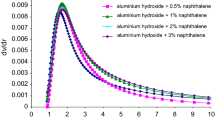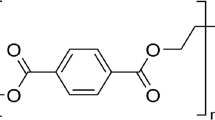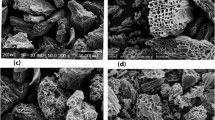Abstract
A study has been performed on the development of an effective process for exhaustive decomposition of organophosphorus compounds (OPC) via their adsorption in carbon sorbent (CS) pores followed by microwave-induced destruction. It has been found that OPC adsorbed in CS pores with an optimal combination of pore structure and the composition of mineral inclusions undergo fast degradation in the space of sorbent pores during microwave treatment and the mineral components of CSs exhibit a catalytic activity, accelerating the degradation process. It has been shown that the designed process for the effective decomposition of OPC is a fundamentally new approach ensuring the exhaustive detoxification of compounds that pose environmental problems.
Similar content being viewed by others
References
Knun’yants, I.L., Makeev, N.N., and Petrov, K.A., Khimiya otravlyayushchikh veshchestv (Chemistry of Warfare Agents), Moscow: VAKhZ, 1953, vol. 1.
Franke, S., Franz, P., and Warnke, W., Lehrbuch der Militärchemie, Berlin: Militärverlag der DDR, 1967.
Aleksandrov, V.P. and Emel’yanov, V.P., Otravlyayushchie veshchestva (Chemical Warfare Agents), Moscow: Voenizdat, 1990.
Korobeinichev, O.P., Shvatsberg, V.M., and Shmakov, A.G., Khim. Fiz., 2008, vol. 27, no. 11, p. 5.
RU Patent No. 2296164 (2005).
RU Patent No. 2261911 (2004).
Golyshkov, B.V., Komissarov, A.N., and Nikiforov, G.E., Inf.-Anal. Sb. Fed. Region. Probl. Unichtozheniya Khim. Oruzh., 2005, no. 6, p. 27.
Mel’nikov, N.N, Taran, P.N., and Shevchenko, M.A., USSR Inventor’s Certificate No. 4631183, Byull. Izobret., 1987, no. 47.
RU Patent No. 6596915 (2003).
Kosarev, V.V., Zhestkov, A.V., and Lotkov, V.S., Ekologiya Cheloveka, 1999, no. 2, p. 30.
Tsodikov, M.V., Perederii, M.A., Maksimov, Yu.V., et al., Ross. Nanotekhnol., 2006, vol. 1, p. 153.
Tsodikov, M.V., Perederii, M.A., Gurko, A.A., et al., Naukoemkie Tekhnol., 2007, no. 4, p. 49.
Pozar, D.M., Microwave Engineering, 2nd ed., New York: Wiley, 1998.
Hayes, B.L., Microwave Synthesis: Chemistry at the Speed of Light, Matthews: CEM Publishing, 2002.
Mingos, D.M and Whittaker, A.G, in Chemistry under Extreme or Non-Classical Conditions, Eldik, R.V. and Hubbard, C.D., Eds., New York: Wiley, 1997
Perederii, M.A. and Noskova, Yu.A., Solid Fuel Chem., 2008, no. 4, p. 219.
Kabachnik, M.I. and Mastryukova, T.A., Mezhfazovyi kataliz v fosfororganicheskoi khimii (Phase-Transfer Catalysis in Organophosphorus Chemistry), Moscow: Editorial URSS, 2002.
Durka, T., Gerven, T., and Stankiewicz, A., Chem. Eng. Technol., 2009, vol. 32, no. 9, p. 1301.
Raid, D., http://home.c2i.net/metaphor/mvpage.html .
Liao, X.-H., Zhu, J.-M., Zhu, J.-J., Xu, J.-Z., and Chen, X-V., Chem. Commun., 2001, no. 3, p. 937.
Wang, X., Zhang, T., Xu, S., and Sun, X., Soc. Chem., 2000, vol. 4, p. 279.
Author information
Authors and Affiliations
Corresponding author
Additional information
Original Russian Text © M.V. Tsodikov, M.A. Perederii, A.V. Chistyakov, G.I. Konstantinov, B.I. Martynov, 2012, published in Khimiya Tverdogo Topliva, 2012, No. 1, pp. 39–47.
About this article
Cite this article
Tsodikov, M.V., Perederii, M.A., Chistyakov, A.V. et al. Degradation of organophosphorus compounds adsorbed in carbon sorbent pores. Solid Fuel Chem. 46, 37–44 (2012). https://doi.org/10.3103/S0361521912010132
Received:
Published:
Issue Date:
DOI: https://doi.org/10.3103/S0361521912010132




